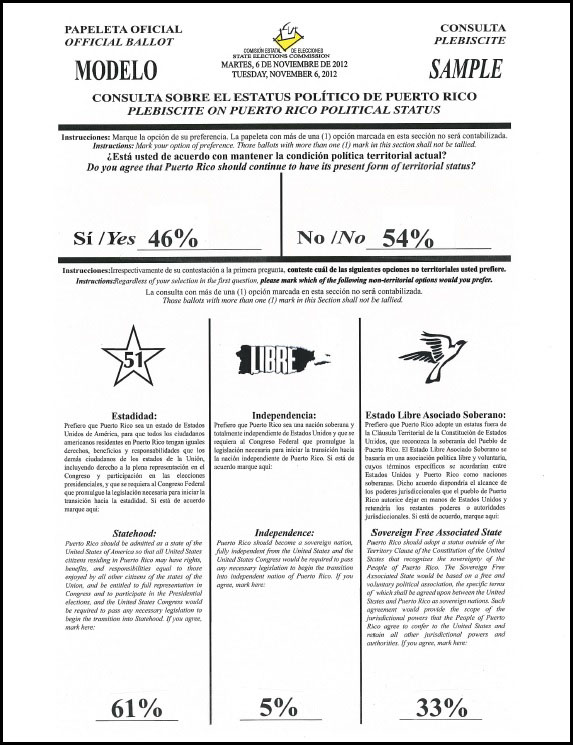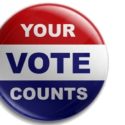Your vote matters, when it comes to political change. We could put it more strongly. If you don’t vote, you don’t matter. That’s why it’s significant that Puerto Rico doesn’t get a vote in presidential elections as the states do. That’s why Puerto Rico’s non-voting Resident Commissioner is not the same as a congressman or senator.
And that’s why the 2012 vote matters, and those who don’t respect it are wrong.
Here you can see the official ballot in Spanish and in English, just as the voters saw it. The official numbers have been put into the blanks, because this is from the certified results of the election.

In 2012, 54% of those voters who answered the first question said that they did not want to continue to be a territory. 61.2% of those voters who answered the second question said the status they preferred was statehood.
Question 1: “Do you agree that Puerto Rico should continue to have its present form of territorial status?”
- no – 970,910
- yes – 828,077
- blank – 67,267
Question 2: “Irrespective of your answer to the first question, indicate which of the following non-territorial options you prefer.”
- statehood – 834,191
- independence – 74,895
- sovereign free associated state – 454,768
- blank – 498,604
Although the White House said back in 2012 that the plebiscite vote was “clear” and many legislators have since then acknowledged that Puerto Rico has rejected the territorial status, there are some — including the current governor of Puerto Rico — who see the numbers differently.
Antonio Sotomayor, in his book, The Sovereign Colony: Olympic Sport, National Identity, and International Politics in Puerto Rico, explains this point of view more clearly than most, though he replaces the term “sovereign free associated state” with “enhanced commonwealth,” which was not actually an option, as you can see from the ballot reproduced above. Here is how he explains the math:
Governor-elect Alejandro Garcia Padilla, who denounced the plebiscite for not following proper democratic procedure, asked his constituents to vote “yes” on the first question and to leave blank the second. Following this line of reasoning, adding the 498,604 blank ballots to the 454,768 votes for enhanced commonwealth would yield 953,372 votes. When compared to the 834,191 votes for statehood, populares claimed, Puerto Rico had once again rejected statehood.
Look what we have to do to make this true:
- We have to accept that people voting for “sovereign free associated state” were actually voting for enhanced commonwealth. “Free associated state” is a clearly defined relationship, and there are currently three nations which are free associated states. “Enhanced commonwealth” is an imaginary status, never clearly defined, which the federal government has repeatedly rejected. There is no real reason to imagine that voters were confused in this way. in fact, Governor Garcia Padilla specifically complained because enhanced commonwealth wasn’t on the ballot.
- We have to accept that everyone who left the second question blank was actually voting in favor of enhanced commonwealth. We have evidence that the current ruling party has asked supporters to leave the second question blank, but there are many other possible reasons that a voter might have left that question blank. They might not have made up their minds. They might have wanted some other option that we don’t know about. They might have wanted to continue as a territory.
- We have to ignore the blank votes for the first question. There were blank votes for the first question, too, but the people making up this story don’t have a way to fit those votes into their story.
- Having redefined the free associated state option and imagined what those who left the second question blank might have been thinking, we have to add the blank votes and the free associated states votes together as if they were the same thing.
Voter turnout was more than 78%. The total number of votes, as a percentage of the population, was larger than the turnout for the presidential elections held in the United States during this century. The governor might have asked his supporters to leave a ballot question blank so that he could later claim all the blank votes. The “commonwealth” party is now, according to gubernatorial candidate Bernier, rejecting the idea of “enhanced commonwealth” and turning toward the option of becoming a free associated state like Micronesia. Perhaps those who counted that option as a vote for “enhanced commonwealth” knew that would happen.
We can speculate, but there is no need to. When people in a democracy vote, their votes are counted as the true expression of their political decisions. U.S. citizens are not required to answer every question; often voters answer some questions and leave others blank. Blank votes are sometimes also cast as a protest, with the message that the voter did not like any of the options. Those votes obviously can’t be added to votes on any of the given options. Voters who cast blank ballots know that their votes are lost: they do not count.
Blank ballots in the 2012 plebiscite didn’t count. When the next plebiscite — funded by the federal government in 2014 — comes along, blank ballots won’t count.
Voting is not the only way to make your voice heard. You can also email your representatives, tweet @them, or tag them n Facebook. Members of the House of Representatives and the Senate pay attention to what their constituents say. If you live in Puerto Rico, let your candidate know that you want the federally-sponsored plebiscite to happen soon. If you live in one of the 50 states, let your representatives know that you want Congress to take action on Puerto Rico’s status.








One response
There is no legal basis for ascribing any legal meaning to a blank ballot unless the ballot instructions inform voters that a blank ballot will have a specific legal meaning defined by applicable law. To ascribe a political meaning to a blank ballot that has no legal meaning is anti-democratic propaganda.